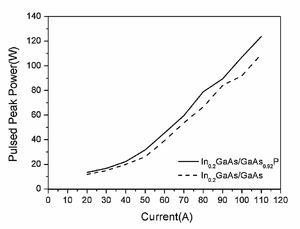- News
16 May 2011
GaAsP barrier used to increase VCSEL array power by 13%
Chinese Academy of Science (CAS) researchers have produced an array of vertical-cavity surface-emitting lasers (VCSELs) with 123W output power at 110A current in pulsed operation [Di Liu et al, Appl. Phys. Express, vol4, p052104, 2011]. The main difference with traditional VCSELs was the use of gallium arsenide phosphide (GaAsP) instead of gallium arsenide (GaAs) for the barriers between the indium gallium arsenide (InGaAs) quantum wells that produced the light emission.
The researchers from Key Laboratory of Excited State Processes at Changchun’s Institute of Optics Fine Mechanics and Physics and Graduate School in Beijing add: “The array device has not been measured to a very high pulsed current because of the voltage limitations of the power supply we used. So far, however, the power density and slope efficiency we obtained from a 4x4 VCSEL array are to our knowledge the highest results reported for a 2D VCSEL array”.
Potential VCSEL applications include high-speed data transmission, high-resolution printing, and pumping of solid-state and fiber lasers due to low threshold current, low divergence angles of the output beam and low cost, compared with edge-emitting semiconductor lasers.
The laser mirrors of the CAS vertical cavity structure consisted of distributed Bragg reflectors (DBR). The top mirror had 28 periods of Al0.9Ga0.1As/Al0.12Ga0.88As, and the bottom mirror 30 periods. Graded interfaces were used in the DBRs to reduce series resistance. Current and optical confinement was achieved through oxidation.

Figure 1: Schematic cross section of 4x4 VCSEL array.
The multi-quantum well (MQW) active region consisted of three strained 8nm wells of In0.2Ga0.8As, separated by 10nm barriers of GaAs0.92P0.08. Devices with traditional GaAs barriers were also produced. The effect of using GaAsP is to widen the energy barrier at room temperature from 1.42eV to 1.51eV. This increases the conduction band offset by 23% and more than doubles the valence band offset.
The researchers comment: “The remarkable increases in both the conduction and valence band offset not only confine electrons well, but have the ability to prevent hole leakage during laser operation. Thus, compared with GaAs, large-bandgap GaAsP barriers can provide better confinement of carriers in the quantum wells, which is good for improving the output power”.
 The devices with 200µm active diameter were arranged in a 4x4 array to give a total emitting area of 0.005cm2. The spacing between devices was 250µm.
The devices with 200µm active diameter were arranged in a 4x4 array to give a total emitting area of 0.005cm2. The spacing between devices was 250µm.
The GaAsP-barrier array produced 123W of output power at 110A current in pulsed operation (60ns, 0.06% duty cycle), compared with 109W for the array with traditional GaAs barriers (Figure 2). The power density and slope efficiency of the GaAsP array were 24.6kW/cm2 and 1.11W/A, respectively.
Figure 2: Peak output power for In0.2Ga0.8As/GaAs0.92P0.08 (solid line) and In0.2Ga0.8As/GaAs (dashed line) QW structures under pulsed operation at room temperature, with 60ns pulses and 0.06% duty cycle.
At 4A, the GaAsP-barrier array produced 1.51W light output in continuous wave (CW) operation, almost double that of a previous GaAs-barrier arrangement with devices of the same active diameter and pumping level. The wavelength of the light from the GaAsP-barrier array was 977.13nm with a full-width half-maximum (FWHM) of 1.0nm.
The threshold current of the GaAsP-barrier array was 0.98A for CW and 0.8A for pulsed operation. However, the CW condition also gives slightly higher slope efficiency, meaning that it gives more power above ~2V, before thermal roll-over (i.e. when sub-linear response to increased current sets in). The researchers attribute the improved slope efficiency (and increased threshold) in CW mode to a number of self-heating effects (thermally induced gain offset, gain suppression, and thermal lensing) that are absent when the current is pulsed.
The researchers also use the ‘p-parameter’ (p = turn-on voltage/(threshold current x differential resistance)) to evaluate their array, finding a value of 15 for CW and 13 for pulsed operation. A high value of p is desired, with values less than 10 considered ‘poor’ and values greater than 50 ‘exceptional’. The researchers describe 15 as being ‘relatively good performance’.
VCSEL achieves 92W output record
The author Mike Cooke is a freelance technology journalist who has worked in the semiconductor and advanced technology sectors since 1997.
